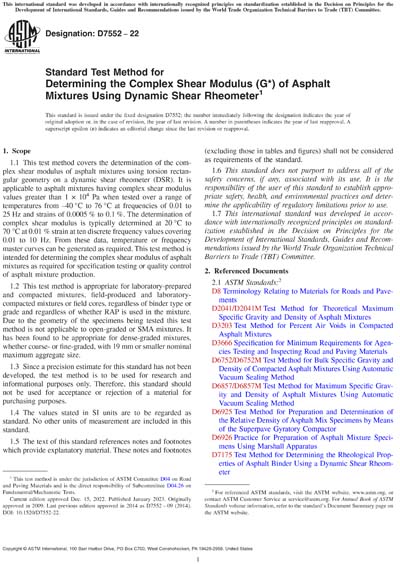Most recent
ASTM D7552-22
Standard Test Method for Determining the Complex Shear Modulus (G*) of Asphalt Mixtures Using Dynamic Shear Rheometer
1.1This test method covers the determination of the complex shear modulus of asphalt mixtures using torsion rectangular geometry on a dynamic shear rheometer (DSR). It is applicable to asphalt mixtures having complex shear modulus values greater than 1 × 104 Pa when tested over a range of temperatures from "“40 °C to 76 °C at frequencies of 0.01 to 25 Hz and strains of 0.0005 % to 0.1 %. The determination of complex shear modulus is typically determined at 20 °C to 70 °C at 0.01 % strain at ten discrete frequency values covering 0.01 to 10 Hz. From these data, temperature or frequency master curves can be generated as required. This test method is intended for determining the complex shear modulus of asphalt mixtures as required for specification testing or quality control of asphalt mixture production.
1.2This test method is appropriate for laboratory-prepared and compacted mixtures, field-produced and laboratory-compacted mixtures or field cores, regardless of binder type or grade and regardless of whether RAP is used in the mixture. Due to the geometry of the specimens being tested this test method is not applicable to open-graded or SMA mixtures. It has been found to be appropriate for dense-graded mixtures, whether coarse- or fine-graded, with 19 mm or smaller nominal maximum aggregate size.
1.3Since a precision estimate for this standard has not been developed, the test method is to be used for research and informational purposes only. Therefore, this standard should not be used for acceptance or rejection of a material for purchasing purposes.
1.4The values stated in SI units are to be regarded as standard. No other units of measurement are included in this standard.
1.5The text of this standard references notes and footnotes which provide explanatory material. These notes and footnotes (excluding those in tables and figures) shall not be considered as requirements of the standard.
1.6This standard does not purport to address all of the safety concerns, if any, associated with its use. It is the responsibility of the user of this standard to establish appropriate safety, health, and environmental practices and determine the applicability of regulatory limitations prior to use.
1.7This international standard was developed in accordance with internationally recognized principles on standardization established in the Decision on Principles for the Development of International Standards, Guides and Recommendations issued by the World Trade Organization Technical Barriers to Trade (TBT) Committee.
Content Provider
ASTM International [astm]






